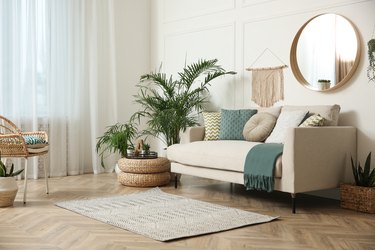
Many people love to use houseplants and flowers to decorate their homes. Quite a few plants will perish quickly unless you place them in locations that only have indirect light. Before you select a plant to add to your décor, study the windows in the room where you plan to put the plant.
In most areas of the country, we have a variety of plants to choose from, for indoor and outdoor use. To select a plant for your decorating needs, you will need some houseplant care knowledge including its watering, light and soil requirements. Many decorative indoor and outdoor plants thrive in bright sunlight.
Video of the Day
Video of the Day
Types of light in the home
Indirect light sources in a room are locations that are not in a direct stream of sunlight, usually at least three feet from sunny windows. Depending on the direction that the window is facing, your plants may have indirect, bright light during most of the day.
North-facing windows and east-facing windows usually have indirect sunlight throughout the day. Most south-facing windows or west-facing windows will have strong direct sunlight from the morning sun or afternoon sun. In most homes, it will be a challenge to find a window that offers plants full sun without using artificial light, such as LED grow lights.
The sun's rays enter each window depending on the time of day and the height and thickness of trees and shrubbery on the property. Nearby buildings can also change the amount of direct light that the sun shines through the windows and the room. A sheer curtain can also decrease direct sunlight while still allowing light to come through.
The effects of too much direct sunlight
When plants that need indirect light are placed in direct sun, they often wilt quickly. Some plant varieties will also turn brown and shed their leaves. Usually, the plant owner will then overwater the plant, thinking that it needs more moisture.
Types of indoor plants that prefer bright indirect light
Some common houseplants that grow better when placed in indirect light include ferns, palms, vines like pothos, and philodendrons. The most common and widely known plant that thrives in indirect light is the mother-in-law's tongue or snake plant. Many people even have success with African violets (a flowering houseplant), when they have suitable humidity levels in the room.
Adjust the amount of light your houseplant receives
You can place plants that do not thrive in direct sunlight up to six feet from a window rather than on the windowsill to reduce their exposure to sunlight. Some plants actually thrive in low light. Place plants that need lower light levels on tables and bookshelves, where no bright sunlight falls directly on them.
If your available indirect light and natural light space is limited, you can use plant lights or full spectrum fluorescent bulbs to adjust light levels and imitate the indirect lighting condition that your plant needs. For best results, position the plant light at least ten inches away from your plant, or consult the instructions from the bulb's manufacturer. Experiment with the distance until your plant is happy.
Plant care and light requirements for optimal plant growth
Turn plants frequently to make sure they get enough light and prevent spindly or lopsided growth. Check the soil for moisture. Many plants only require watering once a week, unless they are exposed to direct sunlight or kept in extremely hot climates. If the soil is moist, but the plant's leaves seem dry, move it farther away from sources of direct sunlight.